The Mini 500 Helicopter Early Days
December 1994 Newsletter – (REPRINT)
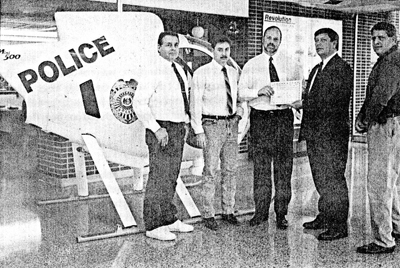
FROM LEFT TO RIGHT: Roger O’Roark, Brian Thomas and Dennis Fetters received certificates in appreciation for their work from Excelsior Springs Chief of Police John McGovern and Detective Steve Taylor.
In the last few months, RHCIs Mini-500 has expanded its mode of operation to assist local law enforcement agencies in accomplishing several tasks.
RHCI President Dennis Fetters said the Mini-500 and pilot services were offered to area police departments to perform any mission in order to prove that the aircraft could do specific jobs and perform as advertised.
The first response was received from the Wood Heights Police Department, who were interested in using the Mini-500 for drug eradication purposes. Within three hours.
RHCI Chief Test Pilot Brian Thomas was able to search the entire city district and report that the district was marijuana-fee — a task that would have taken 10 Wood Heights officers one week to complete.
The next call came from the Excelsior Springs Police Department on the evening of August 27, 1994, on a missing persons’ report.
Richard Drummond, an Excelsior Springs resident and AT&T employee, had reportedly disappeared near Kingdom City, Missouri on August 24 and foul play was suspected. You may have seen the story on “America’s Most Wanted” on September 17. 1994.
According to Excelsior Springs Chief of Police John McGovern. the missing persons’ report led them to Callaway County, Missouri where it became as much of an Excelsior Springs case as a Callaway County case.
As the search unfolded, the immensity of the task became apparent. “We knew we had a large area to search,” he said. “We didn’t know what resources we would have available there.”
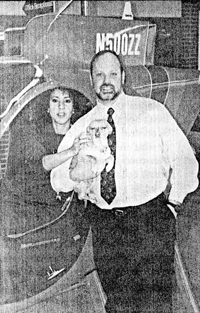
Dennis & Laura G. Fetters with Chico wishing you a very Happy Holidays.
“We needed to provide as many resources as we had available to us. Time was of the essence.” Within one hour after the call, Dennis, Brian Thomas and Roger O’Roark were loading up the Mini-500 to make the 200 mile trip to Kingdom City.
The air search began at 6:30 a.m. on August 28 and continued until 1:00 p.m. “At one o’clock we were basically finished” McGovern said. “With the Mini-500, we were able to cover so much territory—so much land—that six to eight law enforcement personnel and 20 AT&T employees couldn’t begin to cover.”
“The Mini-500 did in one day what, solely manpower, would have taken three full days probably,” he said. “And it was better because they could see down on top of things, get in low and have a good view into wells and other such objects.”
Unfortunately, Drummond turned out to be one victim of a violent crime spree that extended to Arizona, Nevada and Old Mexico, ending with the capture of Dennis Skillicorn and Allen Nicklassen in San Diego, California.
Drummond’s body was found nearly 100 miles from the original search area, just east of Higginsville, Missouri on Sept. 1, 1994, and only by the confession of a juvenile who had accompanied the pair in the first leg of their spree.
The use of the Mini-500 in this type of search thoroughly convinced the police that it could perform its duties flawlessly. Because there is less downwash from the Mini-500, Brian, as pilot and observer, was able to move in and under trees for a closer view without disturbing a possible crime scene.
He was also able to maneuver quickly down into valleys and over hills that would have taken precious time for searchers on foot to cover. Dennis noted that the $10 per hour cost of operation of the Mini-500 compares favorably to $500-700 per hour for a much larger aircraft.
With the use of auto gasoline, they were also able to save time in fueling the aircraft as it was not necessary to fly to an airport to refuel.
McGovern and Excelsior Springs Police detective Steve Taylor agreed that the Mini-500 would be helpful in any type of search, whether it be for people, marijuana plants or in vehicle and ground pursuits, as well as for border patrol and traffic surveillance.
“We hope to use it in the future,” McGovern said. “It is an extremely useful tool in law enforcement.”
LETTERS TO REVOLUTION HELICOPTERS
…I just wanted to let you know what a great time I had at the RHCI factory open house in June of this year The amount of knowledge I gained at the factory was truly amazing.
Being able to see first hand what goes on inside the RHCI factory, one is able to understand and appreciate what a major undertaking the Mini-500 project really is.
The amount of research and development that Dennis and crew have put into the Mini-500 is amazing considering the relatively short time they have had. Their commitment to quality and perfection is second to none!
Don DeSandre
Yonkers, New York
…It was a pleasure meeting you and your stall in June at the Dealers Open House. The factory tour was impressive and a bit more than expected.
The Mini-500 is well-engineered and manufactured. I commend you on a project well done. I believe that my background as a certified Aircraft and Powerplant Mechanic as well as graduate machinist afford me the technical evaluation of the Mini-500 helicopter.
The machining and construction of parts and sub-assemblies match or exceed that of some of the larger aircraft factories.
Fred Pitcher
Inglewood, CA
…I appreciate very much spending time with me outlining your dealership program.
While I haven’t flown your helicopter yet, I did have an opportunity to see it fly at both Sun N’ Fun and Oshkosh this year, and believe your company has finally hit on a design that is affordable,safe and easy to build.
I was so impressed with your aircraft that I purchased one from Bob Dart while in Oshkosh.
Jim Jatha
Evans, Georgia
…After attending both Sun N’ Fun and Oshkosh this year, and seeing first hand the remarkable performance of your Mini-500 in the very capable hands of Dennis and Brian, I am becoming increasingly interested in the possibility that I might be able to learn to fly a helicopter.
So much so that I have made arrangements to start taking helicopter lessons.
Glenn N. Brinker
Fort Wayne, IN
…May I take this opportunity to congratulate Dennis, Laura and Gus plus all the staff at Revolution for the professional approach in which you deal with your customers.
I recently received the latest newsletter which I read avidly over and over again. It is only through this media I tun able to receive news of the Mini-500 progress due to the fact there are about 5000 miles between us.
Congratulations on your success at Oshkosh. I was suitably impressed to read that no other rotorcraft outmaneuvered or put in more air time during the show.
David Waddinqton
England
…In January of this year, I just had to know more about the Mini-500.I made that first step and ordered the video and info pack. I have been stating at that photo for the last nine months.
Last week I received the August newsletter and once again the adrenaline started pumping. But, what finally got me was when I opened up my AOPA Pilot and read that wonderful article written by Tim McAdams.
Bob Jaley
El Toro, CA
…When I first heard about the Mini-500 kit that Revolution Helicopter is developing.I was very interested in learning more about it. “The aiticle in AOPA Pilot made me even more interested as I had been considering building a kit-built airplane for some time.
I am a partner in a Cessna 182 presently so the chance to own and fly a helicopter made more sense than another airplane.I have recently started taking instruction in a Robinson R-22 and find the flying absolutely exhilarating. It is the most fun flying that I have ever done.
George L. Duffy
Beeville, TX
FROM THE PRESIDENT…
Season Greetings! I hope the holidays have found you in good health and the new year greets you with much success. Comparing this year with last year, we can put ’94 behind us with a good feeling of many accomplishments.
Work carries on! In fact, above and beyond all of our other accomplishments, I feel pleased to announce the addition of two components that will be added to the Mini-500 kit.
MINI 500 HELICOPTER KIT ADDITIONS
We have added a new instrument as standard equipment to the Mini-500 kit: the Exhaust Gas Temperature gauge (EGT). The EGT is a gauge that is required to meet the Rotax factory’s warranty program.
This is a useful gauge that will show you changes in your fuel-air mixture ratio, or if some mechanical problems begin to occur. It will instantly read high if the mixture is too lean and read low if the mixture is too rich. Sudden changes in the EGT readings provide an instant warning of potential problems.
Another enhancement that has been added is the rotorblades tips which are now sporting a new rounded teardrop shape that has been added to increase efficiency and to make the Mini-500 quieter than before. This new design has been incorporated into all the blades.
MINI 500 HELICOPTER SHIPPING
Ever since our last newsletter, and before, we have been receiving all the parts necessary to ship out the first large number of aircraft to the next 25 customers. Our goal has been to coordinate all these parts to arrive here at around the same time.
Unfortunately, one of our vendors is still late, but even as we speak, they are preparing the last of our order to be shipped. Fortunately, this vendor is finally our last vendor to be late.
How tough can it be? Well, with over 60 vendors supplying over 3,000 parts per aircraft, it is not uncommon to have one or two suppliers starting out a little slower than the rest, but it’s finally resolved.
I’m happy to say that the first 25 customers have been requested to send in the remaining balance for their aircraft. Shipment of these kits should be accomplished before the end of January 1995.
This will be the break-in period for the factory to come up to speed to accomplish the goal of shipping out one kit every working day. Once this is accomplished, we should be able to give the rest of you a more accurate delivery date for the remaining Mini-500 kits on order.
With this first major shipment, the final leg of our journey will be completed, marking the end of our beginning. What does the future hold? 1995 will be known as the year of the Mini-500 invasion!
1995 will be remembered as the year the Mini-500 was placed in the hands of the public. It will be the year that our competitors will remember as the first year of their worst years to come. We are looking forward to 1995!
EDITORS NOTE
by Laura Gonzalez Fetters
The beginning of a new year is the time to sit down and think about all of your accomplishments throughout the previous year. Here, at RHCI, we have much to feel proud of. This year, we were able to accomplish most of our goals such as:
-
Improvements were done to the cooling and drive system enhancing the performance and reliability of the Mini-500
beyond its original design goals. -
We were able to streamline our manufacturing facility so that we can more efficiently produce the aircraft components.
-
The establishment of our newsletter, “Reaching the Customer,” as a direct communication between RHCI and the customer.
-
We flew and demonstrated the Mini-500 at the Sun N’ Fun and Oshkosh Fly-In (lawlessly and without any failures.
-
Our first Open House allowed us to not only show our customers that we have survived the flood, but to give the general public, and our community, the opportunity to satisfy their curiosity.
-
We have built pride in our community as the technology leaders for kit built helicopters.
-
We showed that the Mini-500 can not only be a sport aircraft, but a servant to mankind through our community involvement. We showed that the Mini-500 is capable of taking on different missions: police work and military tasks to accomplish whatever is requested of it.
-
And above all, final steps towards shipping will be accomplished and finalized as the year ends, making shipping another routine operation within our company.
The New Year will bring what many of you have been waiting for: your very own Mini-500 helicopter. In order to get you ready for that first flight in your Mini-500. Brian Thomas gives you some information about your “first flight” in the Mini-500.
To that end.we have included some information about general requirements for flight instruction in order to get your rotorcraft license. It is very important that you get helicopter training.
You must be qualified to fly helicopters before attempting to fly the Mini-500. Please, call Brian if you need additional information about training.
MINI 500 HELICOPTER PILOT TO PILOT…
by Brian Thomas
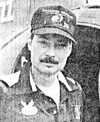
We have been very busy since our last newsletter. All efforts here have been put into getting more aircraft out the door. The Mini-500 is flying superbly, although lately, my time has been needed on so many other important projects that I have not been flying as much as I would like.
Yeah. I know, pilots never fly as much as they would like. But I have gotten some other important things done, like the Pilots Operating Handbook.
It is now ready for final printing and should be available to you alter the first of the year. Very soon many of you will be getting your kits and soon after that, you will be ready for that first flight.
In this issue, I will give you some pointers 011 making that first flight a successful one. The first thing I can not stress enough is to know your own ability. Now is the time to fess up.
If you are a little rusty, get some time in a familiar helicopter to hone your skills. After that, it would probably be of great benefit to get some time in on a different type of helicopter other than what you have flown before.
If you have only flown an R-22, find a Hughes 300 or a Bell 47 or an Enstrom and log a couple of hours. It may still he a good idea to have a very experienced pilot to do the first hover tests. Only you know if you are up to the task or not.
When the aircraft is complete and the FAA has inspected it and issued the airworthiness certificate, it is time to pre-flight. Go by the pre-flight checklist in the Operators Handbook, and be thorough.
When you finish that, do it again. Now you are ready for the initial run-ups and engine break-in. Since this requires you to hove r the aircraft, you will also be checking rigging.
Before you crank the engine, move the flight controls and make sure everything is free and correct. Use the checklist during these run-ups, as you always should. During these initial flights you will need an assistant.
Leave the left side access door off during engine break in so your assistant can watch inside the engine compartment for anything that might come loose or not look right.
If you have followed the assembly manual and engine installation checklist, you should already have the carburetors set, oil and coolant levels full, electrical system checked, weight and balance completed (very important), and blades set to initial track setting.
Run the engine now at idle and set the belt track according to the assembly manual. Use a tracking stick as described in the assembly manual and set the rotor blade ground track. This will get the blades smooth enough to complete the engine break-in.
You may have to tweak the blade track a little bit after a few hours. Remember when everything is new, it is light and a little stiff. After a few hours of break-in, things will free up considerably.
I have only touched on a few of the most important things. If you follow the instructions in the manual you will have covered everything in detail. If everything looks good to this point, you are ready to hover and do the engine break-in procedures.
Choose an area to do this that provides plenty of space. I have to emphasize again that if you don’t feel comfortable doing the first hovers, get someone who you feel is competent to do it for you.
The Mini-500 is one of the most stable hovering helicopters I have ever flown, but it is also very responsive. Once in a stable hover, it does not require much control input to keep it there. Set the RPM at the top of the green before lift off, and keep it there. Don’t be too concerned about over-revving.
It is better to have your rotor RPM in the yellow and bring it back down to the top of the green alter you establish a stable hover, than to let it get low. Remember the Mini-500 has a high inertia rotor system and the RPM will not zing through the roof on you as in other helicopters.
One thing you will notice is that you will have to physically turn your wrist farther to make power changes than in some other helicopters. This is just a characteristic and you won’t even think about it after a few hours.
Follow the manual and take it slow. Don’t try to anticipate what inputs will be needed. Just fly the rotor system and do what needs to be done. If you start to over-control, set it down, take a deep breath and try again.
I am always interested in your opinions. After a few flights write to me with your initial thoughts and experiences. Additionally, we are thinking of opening a flight school here in Excelsior Springs.
We would not only offer initial flight training but also transition courses for the Mini-500. Let me know if this is something you would be interested in. I’m looking forward to seeing many of you at the fly-ins with your aircraft.
Fly Safe
Brian Thomas
Chief Test Pilot
MINI 500 HELICOPTER FLIGHT INSTRUCTION REQUIREMENTS
Receiving quality flight instruction is the first and single most important step you must take to get started in aviation. Listed below is a summary of applicable Federal Aviation Regulations and the options available to you. You do not have to have an airplane rating before you obtain a helicopter rating, although you may get both if you wish.
There are different levels of pilot certificates you may obtain: student, recreational, private, commercial, and airline transport pilot. Each has different requirements and carries different limitations. Federal Aviation Regulations (FAR) part 61 covers pilot certificates and can be obtained at most local airports.
If you currently have a pilot’s certificate with an airplane category rating, you will need to add Rotorcraft-Helicopter to your existing certificate. This requires a minimum of 30 hours, 15 hours dual instruction and 15 hours solo flight. The written test is not required.
If you do not currently have a pilot’s certificate. then you require a minimum of 40 hours, 20 hours dual flight instruction and 20 hours solo flight. You must also pass a written test and a medical exam from an authorized FAA flight surgeon.
During your training, you will have a student pilots certificate. This allows you to train but carries certain limitations that can be found in FAR part 61. Before you start training, you must decide whether to obtain a recreational or private pilot’s certificate.
The minimum hours and training required are nearly the same, but the recreational certificate has more limitations. Usually the private certificate is the better choice. Information on both these certificates can be found in FAR part 61.
FLYING THE MINI-500 HELICOPTER…”A Dream Come True”
This is a articles of articles containing letters written by RHCI customers expressing their thoughts and feelings after flying the Mini-500 for the very first time.
Their feedback will help you in evaluating the Mini-500s performance from someone else’s point of view, and in getting you ready for your first “solo” flight in the aircraft.
Flying the Mini-500 was truly an exhilarating experience, one that I will never forget! The Mini-500 is truly a unique aircraft with control response being somewhat between that of the Robinson R-22 and the Hughes-300C. Start-up and run-up were straightforward.
Lift off to a hover was a little shaky but after talking to Dennis on the radio and settling in and relaxing. the Mini-500 became a joy to fly! My only complaint is that my flight did not last long enough.
I am patiently awaiting the arrival of my Mini-500 kit, and after Hying the demonstrator, I know the wait will be worth it. I am looking forward to the first RHCI fly-in next year and hope to bring a lot of other Mini-500s with me to all the fly-ins across the country.
Don DeSandre
Yonkers, New York
It was a joy to fly the Mini-500. It flies as well and as easily as a much heavier helicopter. I found it to be stable and docile enough for even a low-time rotorcraft pilot. I didn’t know what to expect from the Mini-500, however, the cyclic and pedal authority were more than adequate with the crosswind as I hovered the craft.
Fred Pitcher
Inglewood, CA
First Impressions After Flying the Mini-500
“…settling in and relaxing, the Mini-500 became a joy to fly.”
-Don DeSandre
“(The Mini-500) flies as well…as a much heavier helicopter.”
-Fred Pitcher
LATEST MINI-500 HELICOPTER NEWS
RHCI shipped its first Mini-500 military version for “non-public use,” on August 16. 1994. The aircraft was purchased by a “major military weapons contractor” whom Dennis Fetters had previously done business with as owner of Air Command Mfg., Inc.
At that time, the contractor purchased a classified number of “Commando Gyroplanes,” the military version of Fetter’s gyroplanes.
First “Non-Public Use” Mini-500 Delivered
“We are allowed to announce that we have shipped it and that they have reported back to us that the aircraft is completely satisfactory,” Fetters said. “We are not allowed to discuss where or what they will be using the aircraft for, but we do expect many more orders to come of it in the future.”
The vehicle is expected to serve many military roles. “It provides a reliable, hut inexpensive means of airpower that any friendly country could afford many of” he said.
Record-Breaking Days Continue at RHCI
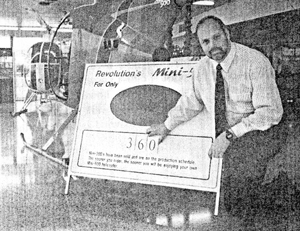
Dennis Fetters happily recognizes a record number of orders.
RHCI once again experienced a world record-breaking day for kit manufacturers, this time receiving in one day 109 orders for the Mini-500 on Oct. 21,1994, the last purchase day for the price of $24,500.
General Manager, Gus Lanz said RHCI received 193 orders in the one-month period from the time the price increase was announced until Oct. 21, doubling the number of Mini-500s on order to 360.
Gus attributed the Hood of orders to the announcement that shipping had begun, as well as the ability to actually see the aircraft fly. The chance to save an extra $2,000 also seemed to be a good incentive to make a purchase.
“Many waited for shipping to begin before they ordered,” he said. “I was definitely surprised. I didn’t expect to get more than 75 orders before the price increase date.” Gus said the price increase was due to the actual cost of the aircraft coming in above what was originally projected for the Mini-500 on paper.
President Dennis Fetters said he was “in awe” of receiving that many orders in such a short time period. “I’m pleased to know that there are many potential customers out there,” he said.
Mini-500 Breaks 111 M.P.H.
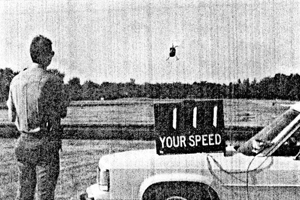
As mentioned in the last newsletter, Chief test Pilot Brian Thomas in the factory Mini-500, was clocked by Sergeant Jeff Kimsey of the Excelsior Springs Police Department, at a speed of 111 m.p.h. straight and level at the Excelsior Springs Memorial Airport runway on August 25, 1994.
Dennis was pleasantly surprised that it exceeded the projected top speed of 95 m.p.h.
MINI 500 HELICOPTER DEALER RECOGNITION… Jeff Burch
Jeff Burch
Sport Helicopters of Florida
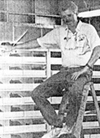
“The Mini-500 is a dream come true as far as design work and simplicity with very little maintenance required.”
– Jeff Burch (shown here during RHCI’s Open House ’94)
Jeff Burch saw the Mini-500 mock-up, along with the transmission and tail rotor for the first time at Sun N’ Fun in 1991 and that was enough to get him interested. Jeff has been at every Sun N’ Fun since then, sf tending the days helping RHCI set up and promote the Mini-500.
Thank you, Jeff, for your help and dedication over the years!
Starting out in 1967 as an aerial photographer, Jeff Burch learned how to fly on a Piper PA 11 Cub which he overhauled and restored with the help of his father.
Jeff’s interest in helicopters was sparked when he first saw a Rotorway back in 1987 and decided to build his own. He took it to Sun N’ Fun ’88 and received the Grand Champion Rotorcraft Award.
From then on, Jeff attended every Sun N’ Fun with his Rotorway until he saw Dennis Fetters’ Mini-500 at Sun N’ Fun ’91. All Jeff was able to see at this show was the Mini-500 mock-up display. “The only parts Dennis had at the show were the transmission and tail rotor assembly,” Jeff said.
“And I liked the gear drive because it is shaft-driven. The Rotorway I built had a series of belts and chains that drove the main rotor and they needed constant adjustment.” Jeff immediately became so interested in the Mini-500 that he decided to sell his Rotorway to buy a Mini-500.
He became RCHI’s first dealer in March 1991. “I became a dealer because I enjoy helicopters so much and I thought it would be appropriate,” Jeff said. “I was interested in seeing Dennis and Laura succeed and wanted to be a part of it.”
Since that time, Jeff and his wife, Priscilla, have had a lot of fun helping Dennis and Laura at Sun N’ Fun. They always arrive at the show few days early to make sure everything is in order. “I can’t wait to have my Mini-500 early next year,” said Jeff.
“The Mini-500 is such an excellent machine that it reminds me more of a certified design than a homebuilt.” Jeff has single and multiple engine ratings, as well as ratings for rot ore raft and glider. He has 3500 total hours with about 350 in helicopters.
Jeff and Priscilla moved to Boynton Beach airport at Willis Gliderport to have their home and hangar in the same location, while reducing their aerial photography business in order to accommodate their Mini-500 dealership, This net up is in fact for their customers to fly in and check out the Mini-500, as well as for holding seminars.
They have also added an office onto their hangar. Jeff and Priscilla have two children: 10-year-old David and 18-year-old Katie. Katie will attend the US Naval Academy at Annapolis next year.
Future plans: “I plan on going to Rotax school to become a certified repair station,” Jeff said. “I’m looking forward to when I get my helicopter and plan on flying all over my territory to all airports with FBO’s to promote the Mini-500.”
“I want to be the best dealer Revolution Helicopter has, not necessarily in volume, but in service to customers and representing them in a professional manner,” Jeff said. “I’m really looking forward to the whole venture.”
The Mini-500 Helicopter (April 1991)
Since 1955, when he was 18 years old, Augusto Cicare has built and flown six homebuilt helicopters. Because materials and parts were scarce in his native Argentina, he had to scrounge and innovate—he even had to build his own engines—but all of his helicopters did fly. The design concept and handling qualities of his latest design, the X101, caught the eye of Air Command gyroplane designer Dennis Fetters almost two years ago.
Since then, the two have collaborated to form the Revolution Helicopter Corporation Inc. to market the helicopter in the U.S. The single-seat X101 incorporates teetering composite main rotor blades, a semi-rigid articulated rotor head and no flapping hinge. The powerplant is a Rotax 582 with a four-belt reduction drive for the first stage and power engagement, and a second gear transmission through a 90° gearbox. A shaft drives the metal tail rotor.
The Mini-500 will incorporate the dynamic features of the X101, but the airframe will be lightened and aesthetically enhanced with the addition of a Helico-molded fiberglass shell that will make the X101 look like a small Hughes 500 helicopter.
The two-blade main rotor is 20 feet in diameter and the tail rotor is 3.5 feet long. Including the rotor blades that extend out ahead of the cockpit, the Mini-500 is 22 feet long and 8 feet 1 inch high. The skid-type gear is 5 feet 3 inches wide. With an empty weight of 315 pounds and a maximum useful load of 400 pounds, the Mini-500 will gross at 715 pounds.
Cruise speed of the prototype is 55 mph, but with a more-powerful engine and the Mini-500 shell installed, that is expected to increase to 75 mph. Maximum level speed will be 95 mph; VNE 150 mph. Climb rate is projected to be 1100 fpm. While the prototype X101 has only a 4.5-gallon fuel tank, the Mini-500 will have a 15-gallon tank and an endurance of more than three hours.
The first 10 Mini-500 kits sold for $17,995 and will include the 67-hp, dual-ignition Rotax 582, electrical system, starter and instruments. Kits now carry a price tag of $21,995. Kit assembly is expected to take no longer than a week and field setup only 10-15 minutes. “Operating cost,” says Fetters, “can be as low as $7.50 per hour,” which is exceptional for any true helicopter.
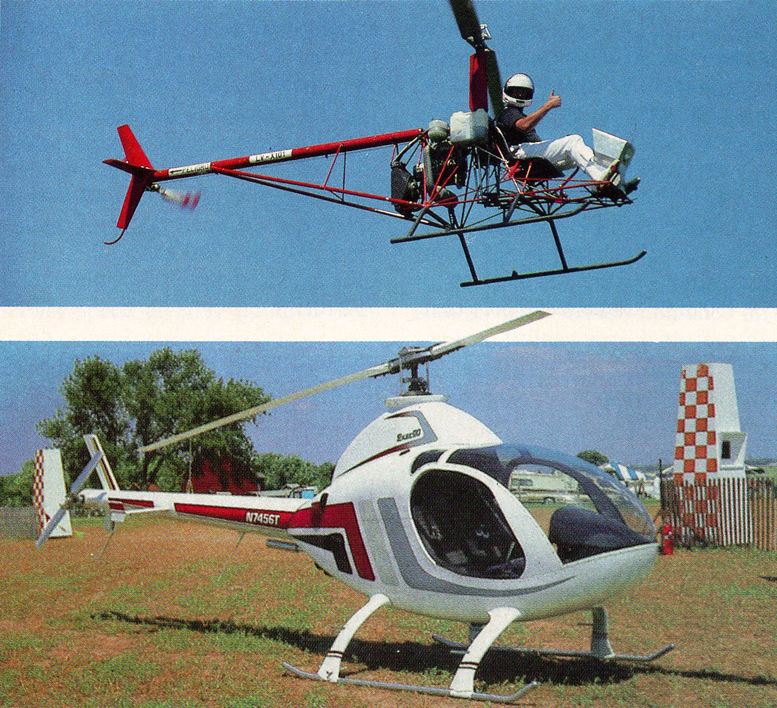
At Oshkosh, Dennis Fetters demonstrated the precise handling characteristics of the XI01 by tipping over parking cones, picking them up and moving them, then tipping them rightside up again.
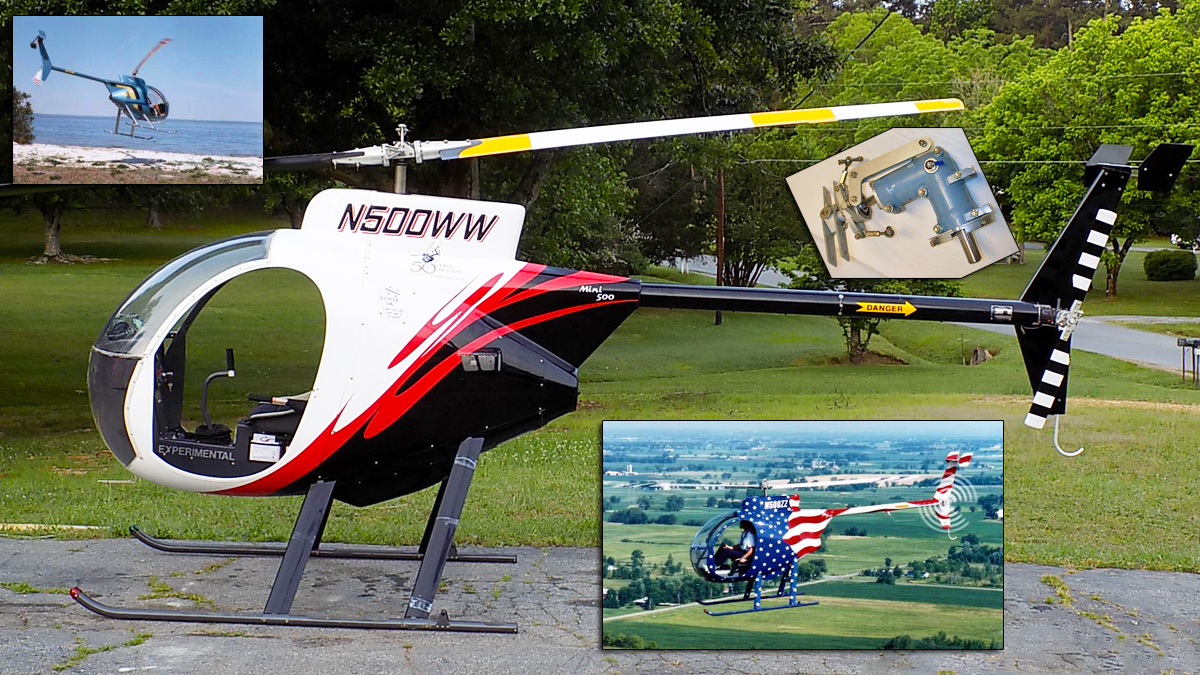

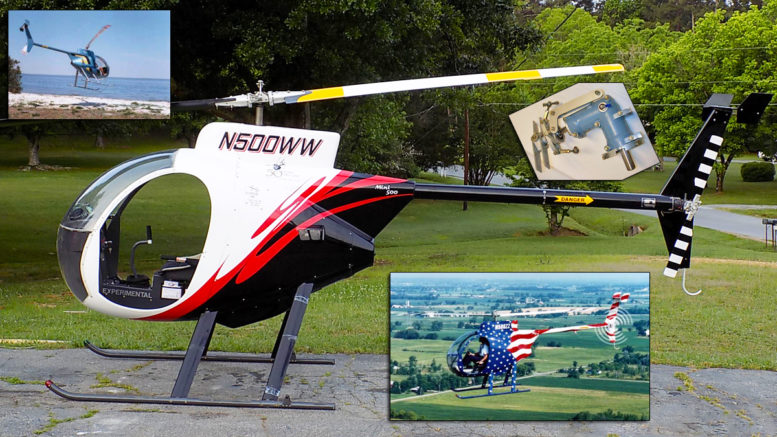
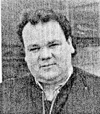
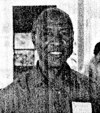

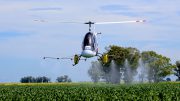
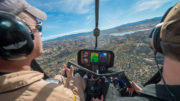
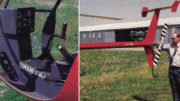
Be the first to comment on "Mini-500 Helicopter To The Rescue"